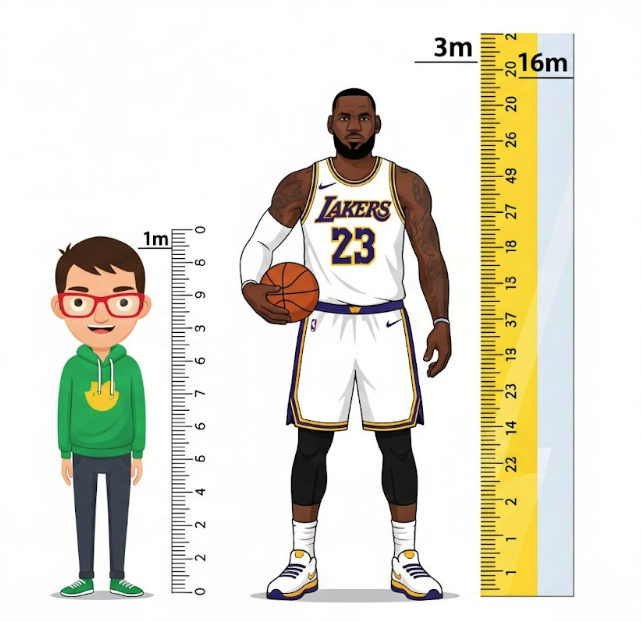How Can You Accurately Compare Your Height With a Famous Athlete?
Have you ever watched your favorite basketball player dominate the court and wondered how you’d measure up standing next to them? Or seen a gymnast soar through the air and questioned whether you’re taller or shorter than these incredible athletes? Comparing your height with famous athletes isn’t just fun—it offers insight into the physical demands of different sports.
From towering basketball centers to compact, agile gymnasts, success in sports isn’t about one ideal body type. It’s about how well an athlete uses their natural build. Understanding these differences can be motivating, helping you discover which sports might suit your height and how to embrace your athletic potential.

Why People Want to Compare Heights with Athletes
Height comparisons with famous athletes happen for many different reasons. For young people, especially, seeing how they measure up to their sports heroes can be exciting and motivating. It helps them understand whether they might have the physical traits needed for certain sports or positions.
Understanding height differences also helps fans appreciate the unique physical qualities that make athletes successful. When you realize that some of the world’s best soccer players are shorter than average, it shows that athletic success comes from skill, training, and determination, not just height.
Many people also use these comparisons to better understand their body proportions and how they relate to different sports. If you’re considering trying a new sport, knowing how your height compares to successful athletes in that field can help you understand potential advantages or challenges you might face.
What Are the Best Tools and Methods for Accurate Height Comparison?
Accurately comparing your height to athletes or celebrities can be fun and informative. These are some of the most effective tools and techniques you can use:
Using Online Height Comparison Tools
The internet offers several online tools, like easyheightcomparison.com, for comparing your height with famous athletes. These digital tools allow you to input your height and immediately see visual representations of how you compare to athletes from different sports. Many of these tools use verified athlete heights from official sources.
When choosing an online comparison tool, look for ones that clearly state their sources and update their information regularly. Some tools even allow you to compare multiple athletes at once, giving you a broader perspective on height differences across sports.
These digital tools are convenient and usually free, making them an easy first step in your height comparison journey. However, always double-check the athlete heights they use against multiple reliable sources.
Manual Calculation Methods
If you prefer doing the math yourself, manual calculation is straightforward once you have accurate height measurements. Start by converting all heights to the same unit – either inches or centimeters – to avoid confusion.
To find the difference, simply subtract the smaller height from the larger height. For example, if you’re 5 feet 8 inches (68 inches) and want to compare with an athlete who is 6 feet 2 inches (74 inches), the difference is 6 inches, with the athlete being taller.
Keep a notebook or digital file where you record these comparisons. This helps you build a personal database of how you compare to different athletes and can be interesting to look back on over time.
Visual Comparison Techniques
Creating visual comparisons can make height differences more meaningful and easier to understand. You can do this by standing next to a wall and marking your height, then marking where famous athletes would reach based on their listed heights.
Another visual method involves using everyday objects to represent height differences. For example, if an athlete is 4 inches taller than you, you can hold a standard smartphone (which is about 5-6 inches long) above your head to visualize approximately where the athlete’s head would be.
Photo editing software also allows you to create side-by-side comparisons by scaling images properly. This method requires more technical skill but can produce very realistic visual comparisons.
What Should You Know About Understanding Athlete Height Measurements?
When comparing athlete heights, it’s important to understand how and where those measurements come from. Here are some key differences to be aware of:
Official vs. Listed Heights
Not all athlete height measurements are created equal. Many sports organizations list heights that might be slightly different from actual measurements. Basketball players, for example, are sometimes listed at heights that include their shoes, which can add an extra inch or two to their real barefoot height.
Professional sports leagues have different standards for measuring height. Some measure players in shoes, others measure barefoot, and some use measurements from years ago that might not reflect current height. This means you need to be careful about which source you trust for athlete height information.
The most accurate measurements usually come from official medical examinations, draft combines, or Olympic records. These measurements are typically taken barefoot and follow strict protocols to ensure accuracy.
Height Variations in Different Sports
Different sports tend to attract athletes of different heights, and understanding these patterns can help you make more meaningful comparisons. Basketball players are generally much taller than average, with many NBA players standing over 6 feet 6 inches tall. In contrast, gymnastics tends to favor shorter athletes who can perform rotations and maneuvers more easily.
Swimming has athletes of various heights, but longer limbs often provide advantages in the water. Track and field includes everything from tall high jumpers to shorter distance runners, showing that success comes in many different body types.
Understanding these sport-specific height trends helps you make more realistic comparisons and better understand why certain athletes excel in their chosen sports.
How Can You Create a Personal Database to Track and Compare Athlete Heights?
Tracking the heights of your favorite athletes can be both fun and insightful. Start by creating a personal database, recording each athlete’s height along with the source and any relevant context, such as position or sport. Organize your data by categories like sport or role to spot patterns more easily.
To make comparisons more tangible, create visual references—such as wall charts or digital mockups—that show how each athlete’s height compares to yours. Photos next to known-height objects or edited images can make abstract numbers feel real.
Updating your database and visuals regularly keeps your reference current and engaging. Over time, this project becomes a valuable tool for understanding athletic body types and how your measurements stack up in the world of sports.

Conclusion
Comparing your height with a famous athlete can be a fun and interesting way to connect with your favorite sports stars. By using a height comparison tool, you can gain a better understanding of the physical characteristics of athletes and see how you might stack up.
Whether you’re a fan of basketball, football, or tennis, knowing how your height compares to a famous athlete can be a great way to appreciate their skills and abilities.
